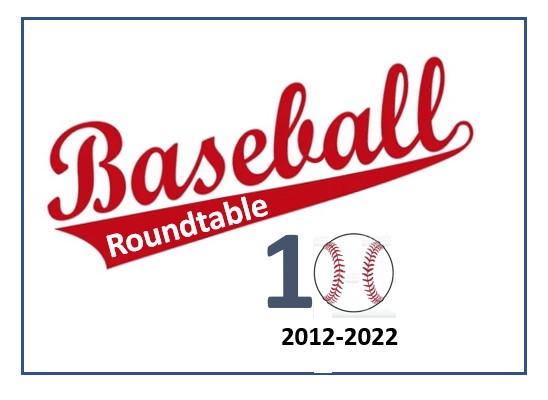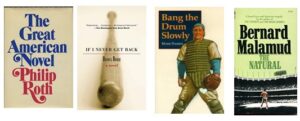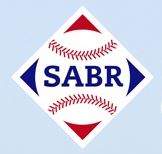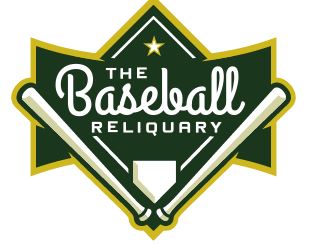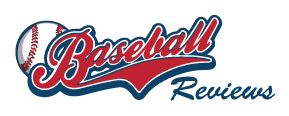In this tenth anniversary post, Baseball Roundtable will present some highlights from past posts, as well as the listings of The Roundtable’s ten favorite fiction and non-fiction baseball books.
Today (March 18), marks the tenth anniversary of Baseball Roundtable. Over that span, Baseball Roundtable has published 887 posts – covering baseball past, present and, occasionally, future – with a combination stats and stories, observation and opinion (mine and the readers’). On these pages, The Roundtable has launched:
- The Annual John Paciorek Award – honoring players with brief, but in some way notable, baseball careers. For the latest JPA post – with a link to all the JPA offerings, click here.
- The “Who’s Your Daddy?” Series – presenting position-by-position lineups of players who performed exceptionally well against some of the best pitchers of all time. For the latest “Who’s You Daddy?” post, which includes links to the entire series, click here.
- The Baseball Roundtable Trot Index – tracking the percentage of plate appearances that result in a “trot” – around the bases (home run); back to the dugout (strikeout); or to first base (walk, hit by pitch, catcher’s interference.)
- The annual Baseball Roundtable Unofficial Fan Hall of Famed Ballot, as well as fan surveys on the baseball experiences (time of game, concessions, etc.), proposed rule changes and the general state of the game.
- Lists covering topics from Baseball Roundtables’ favorite baseball quotes, nicknames and baseball cards.
Baseball Roundtable has also offered month-by-month MLB season summaries – with team and individual stats, stories (highlights) and Baseball Roundtable’s Players, Pitchers and Surprise of the Month. There have also been a host of predictions, trivia questions, book reviews – (and interviews with authors). And, of course, there’s been plenty of musings about the national pastime (that, as regular readers know, provide proof of Baseball Roundtable’s assertion that when I research a hardball topic “one thing always leads to another.” Baseball Roundtable has also featured guest posts by former players; coaches; sportswriters; writers from such websites as LiftYourGame.net, CatcherHome.com; The BaseballReviews.com; OldSportCards.com; I70Baseball.com; and even an Emmy Award Winner.
So, to get this tenth anniversary post rolling, here are my ten favorite hardball tidbits (with a few “extras”) from past posts (not necessarily the ten best, just those that seem to have stuck with me over time.
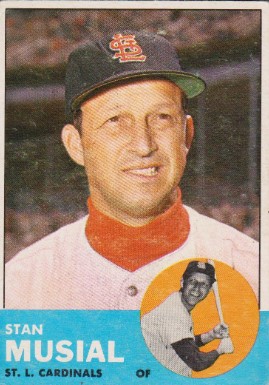 NUMBER ONE. This story has been told often, but it remains The Roundtable’s favorite baseball coincidence. On May 2, 1954, Stan “The Man” Musial had one of the greatest days at the plate in major-league history. That day, the New York Giants faced Musial’s Cardinals in a double header before 26,662 fans at Busch Stadium (I). Game One, a 10-6 Cardinal win, saw Musial go four-for-four with three home runs (his first-ever three-homer game) and six RBI. In Game Two, a 9-7 Cardinals’ loss, Musial went two-for-four, with two home runs and three RBI – becoming the first player ever to hit five home runs in a doubleheader.
NUMBER ONE. This story has been told often, but it remains The Roundtable’s favorite baseball coincidence. On May 2, 1954, Stan “The Man” Musial had one of the greatest days at the plate in major-league history. That day, the New York Giants faced Musial’s Cardinals in a double header before 26,662 fans at Busch Stadium (I). Game One, a 10-6 Cardinal win, saw Musial go four-for-four with three home runs (his first-ever three-homer game) and six RBI. In Game Two, a 9-7 Cardinals’ loss, Musial went two-for-four, with two home runs and three RBI – becoming the first player ever to hit five home runs in a doubleheader.
Why is this event at the top of this list? Well. among the 26,662 fans witnessing Musial’s feat was eight-year-old Nate Colbert – who, on August 1, 1972, would become the second player in MLB history (and there are still only two) to hit five round trippers in a double header. In Game One of that doubleheader (Padres at Braves), Colbert went four-for-five, with two home runs and five RBI, as the Padres won 9-0. In Game Two, an 11-7 Padres’ win, Colbert went three-for-four with three home runs and eight RBI. Stan Musial, however, was not in the crowd. (Now, that would really have been a coincidence.)
NUMBER TWO. This one falls into Baseball Roundtable’s “iconic and ironic” list. I’ve always been impressed by the fact that the first National League (any position) to hit two Grand Slams in a game was a pitcher – Tony Cloninger, who did it in a Braves 17-3 win over the Giants on July 3, 1966. Cloninger collected a pitchers’ record nine RBI in the game – and also threw a complete-game seven-hitter. This tidbit gets “extra credit” when you add the fact that, after retiring from MLB, Cloninger became a world-class slow-pitch softball player. In 1978 (six years after his MLB retirement), playing for the United States Slow-Pitch Softball Association’s Slow-Pitch World Series Champion Howard & Carroll team, Cloninger was selected as the third baseman on the Series All-World Team. For trivia buffs, Cloninger used Denis Menke’s bat to hit that pair of Grand Slams.
Baseball Roundtable Tenth Anniversary Extra
On August 15, 1962, as the Philllies topped the Mets 9-3 in the first game of a twin bill, Phillies’ starting left fielder Don Demeter touched up starting pitcher right-hander Bob Miller (Robert Lane Miller) for a third-inning, solo home run. In the ninth frame, Demeter (who had now moved to CF) hit a three-run home run, this time off left-handed reliever Bob Miller (Robert Gerald Miller). So, two home runs in one game off two Bob Millers, one southpaw and one righty, one starter and one reliever, while in the lineup at two different positions.
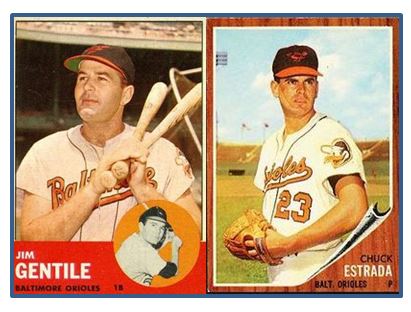 NUMBER THREE. In 1961, the Orioles’ Jim Gentile tied the MLB record and set a new AL mark (both since broken) for Grand Slams in a season with five bases-loaded long balls. Every one of Gentile’s five four-run blasts was hit in a game started by Orioles’ righty Chuck Estrada (who, as you would expect, picked up a victory in all four contests). Added credit for the fact that Gentile hit only one other Grand Slam in his career (June 26, 1960) and – you guessed it – the starting and winning pitcher in that contest was Chuck Estrada – and for the fact that this was the first trivia question I ever posed on a Ballpark Tours trip.
NUMBER THREE. In 1961, the Orioles’ Jim Gentile tied the MLB record and set a new AL mark (both since broken) for Grand Slams in a season with five bases-loaded long balls. Every one of Gentile’s five four-run blasts was hit in a game started by Orioles’ righty Chuck Estrada (who, as you would expect, picked up a victory in all four contests). Added credit for the fact that Gentile hit only one other Grand Slam in his career (June 26, 1960) and – you guessed it – the starting and winning pitcher in that contest was Chuck Estrada – and for the fact that this was the first trivia question I ever posed on a Ballpark Tours trip.
Baseball Roundtable Tenth Anniversary Extra
In 1987, Yankees’ first baseman Don Mattingly set an MLB single-season record (since tied) with six Grand Slams. Despite a 14-season career that included 163 bases-loaded plate appearances, Mattingly did not hit another Grand Slam before or after those record-setting six.
NUMBER FOUR. On July 27, 1998, Tyrone Horne (Double-A Arkansas Travelers) became the first (and still only) professional ballplayer to hit for the “Home Run Cycle” – popping a solo, two-run, three-run and Grand Slam home run in one game (a 13-4 road win over the San Antonio Mission). Horne never made it to the major leagues, completing a 13-season minor-league career with a .288 average and 143 home runs.
NUMBER FIVE. On August 14, 1958, the Indians’ Vic Power tied an MLB record by stealing home an MLB record-tying twice in one game – the second of which came in the bottom of the tenth inning, giving the Indians a “run-off” 10-9 win over the Tigers. Why does this feat rank so high on my list? Power stole only three bases during the entire 1958 season.
Baseball Roundtable Tenth Anniversary Extra
Babe Ruth had more inside -the-park home runs and more steals of home than Ricky Henderson.
NUMBER SIX. Ron Wright played professional baseball from 1994-2004, but got only one game in the big leagues. As his Mariners took on the Rangers (in Texas) on April 14, 2002, Wright started at DH. That day he would see nine pitches in three plate appearance and be responsible for six outs. In his first plate appearance, he struck out on three pitchers, with two runners on base (second inning). He came up with two on again in the fourth and hit into a triple play on a 2-2 pitch (although there were some baserunning miscues that contributed … the play went 1-6-2-5-1-4). Wright came up again in the sixth, again with two on, and hit the first pitch he saw into a traditional 6-4-3 double play. The Mariners pinch hit for Wright in the seventh – and he never appeared in a major league game again.
Baseball Roundtable Tenth Anniversary Extra
John Miller hit just two home runs in his MLB career – one for the Yankees in 1966 and one for the Dodgers in 1969. Those blasts mad him one of just two MLB players to homer in their first and last MLB plate appearance.
NUMBER SEVEN. Only five times in MLB history has a pitcher fanned 20 batters in nine innings – Roger Clemens (twice); Kerry Woods; Max Scherzer; and Randy Johnson. (Johnson was the only non-complete game. He fanned twenty in nine innings, but was relieved by Byung-Hyun Kim in the top of the tenth with the score tied 1-1.) The tidbit that attracted me here is that is that in those five 20-strikeouts outings, these dominating pitchers did not walk a single batter. That’s right, 100 whiffs and not a single walk.
Baseball Roundtable Tenth Anniversary Extra
In 2021, Padre’s reliever Austin Adams led MLB in batters hit-by-pitch with 24. The curveball here? He only pitched 52 2/3 innings – the fewest innings ever pitched in a season of 20 or more HBP. To find the second-fewest, you have to go all the way back to Ed Doheny, who hit 22 batters in 1900 – in 133 2/3 innings pitched. Further, Adams’ 24 plunkings are the most since Jack Warhop’s 26 in 1909 (and he pitched 243 1/3 innings that season).
NUMBER EIGHT. The final score of the Yankees/Red Sox game on October 1, 1961 – when Roger Maris hit his historic 61st home run (breaking Babe Ruth’s long-standing single-season record) was 1-0. Despite the chance to witness history, only 23,154 fans were in attendance – just 34 percent of Yankee Stadium’s listed capacity at the time (67,337). That means, of course, about two of every three seats were empty.
Baseball Roundtable Tenth Anniversary Extra
Casey Stengel, while a member of the New York Giants, hit the first-ever inside-the-park and over-the-fence post-season home runs in Yankee Stadium, (Games One and Three of the 1923 World Series.)
NUMBER NINE. On July 17, 1990, facing the Red Sox in Boston, the Minnesota Twins became the first (and still only) team to turn two triple plays in a single game. They came in the fourth and eighth and both were the purist triple killings possible – grounder to third (Gary Gaetti) for a force and then a relay to second (Al Newman), then on to first (Kent Hrbek). What adds to this remembrance is that the very next day, the Twins turned six double plays, which gave them share of the AL record for double plays turned in single game – and, add the four double plays turned by the Red Sox, and the Twins and Red Sox set the record for combined double plays in a single game.
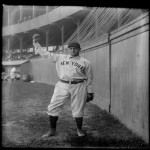 NUMBER TEN. In August of 1903, the Giants’ Joe McGinnity started both games of a double header three times (August 1, 8 and 31), pitched six complete games and won them all, giving up just ten runs. What puts this on this list is, that same month, McGinnity pitched just one game on six other occasions – going 1-5 and giving up 28 runs. Apparently, he liked a full day’s work.
NUMBER TEN. In August of 1903, the Giants’ Joe McGinnity started both games of a double header three times (August 1, 8 and 31), pitched six complete games and won them all, giving up just ten runs. What puts this on this list is, that same month, McGinnity pitched just one game on six other occasions – going 1-5 and giving up 28 runs. Apparently, he liked a full day’s work.
Baseball Roundtable Tenth Anniversary Extra
In 1946, the Boston Braves played a record 46 doubleheaders – including a record nine consecutive twin bills between September 4 and September 15. In those doubleheaders, they recorded 42 wins, 48 losses and two ties.
___________________________________________________________
Baseball Roundtable’s Big Surprise
Ten years ago, when I was searching for a domain name for this blog, I was surprised to find my first choice – baseballroundtable.com – was available.
___________________________________________________________
Now, let move on to Baseball Roundtable’s list of favorite baseball books (baseball is, after all, the most literary of sports). Two things to keep in mind: 1) This is a subjective list. I do not maintain that thee are the “best” baseball books, but just (for various reasons) my favorites; 2) To qualify for this list, these books had to be on may “fan cave” bookshelves.
Non-Fiction
- The Baseball Encyclopedia (Macmillan) and ESPN Baseball Encyclopedia … A treasure trove of statistical information. I’ve spent (and still spend) more hours than I’d like to admit, pouring over these pages and pages of numbers. Open to any page and you’re likely to find something “new.” Sadly, the “newest” edition on my bookshelf is from 2008.
- The Glory of Their Times, by Lawrence S. Ritter … A look at the early day of bases through the eyes (and words) of those who played the game.
- Only the Ball was White, by Robert Peterson … A must read look at the Negro Leagues.
- The Summer of Bear and Whiskey, by Edward Achorn … A wild and wooly – and true – tale of baseball in the 1880s.
- Eddie Mathews and the National Pastime, by Eddie Mathews and Bob Buege … This book gets a spot in the top five since Ed Mathews is my all-time favorite player – and this read will tell you he was a pretty colorful bruiser and basher, with a great love of the game.
- The Baseball Maniac’s Almanac, by Bert Sugar … Page upon page of all-time baseball trivia and tidbits. Want to know which brothers played together as MLB double play combinations, which players hit World Series home runs for three different teams or see a list of MLB pitchers who have stolen home (there are more than you’d think)? It’s all here (and more).
- The Baseball 100, by Joe Posnanski … An entertaining and informative look at Posnanski’s 10o greatest players – full of fun stories, fascinating facts and a feel for the game and those who played it. Sure to move up my list as I spend more time with this recent edition to my library.
- Ball Four, by Jim Bouton … A first glimpse into the MLB club house that really needs no explanation.
- Baseball Nicknames – A Dictionary of Origins and Meanings, by Jakes K. Skipper, Jr. … A fun look at what’s behind more than 4,000 baseball nicknames. Where else can you learn why Lou Gehrig was once known as “Biscuit Pants” or how “Sparky” Anderson got his nickname. Indexed by player’s last name, as well as by nicknames, for easy reference.
- Catcher in the Wry, by Bob Uecker … Great entertainment from a truly funny former major leaguer.
There are, of course, dozens upon dozens of worthwhile baseball reads like: 24, Life and Stories from the Say Hey Kid; Satchel, the Life and Times of a Legend; Why Time Begins on Opening Day; Veeck as in Wreck; and I could go on and on (but I had to pick just ten). Also, I’d be remiss if I didn’t mention another go to book for Baseball Roundtable, The Elias Book of Baseball Records.
Fiction
- The Great American Novel, by Philip Roth … The story of the Ruppert Mundys … a 1940’s team of shallow skills and deep neurosis, that (due to wartime circumstances) played the an entire season on the road. Hard to describe … Fun to read.
- If I Never Get Back, by Darryl Brock … A modern player steps off a train and into 1869, where he joins up with the Cincinnati Red Stockings.
- Bang the Drum Slowly, by Mark Harris … A heart-tugging baseball story (and a pretty good movie, too).
- The Natural, by Bernard Malamud … Darker than the movie, but the story of Roy Hobbs is compelling.
- Shoeless Joe, by W.P. Kinsella … “If you build it, he will come.” Nothing more needs to be said.
- Home Game, by Paul Quarrington … A combination of humor and compassion, Home Game is the story of a down-on-his-luck former major leaguer who is drawn into a conflict between a group of circus sideshow performers and a conservative religious sect … that ends in a high-stakes baseball game between the two factions.
- The Iowa baseball Confederacy, by W.P. Kinsella … In 1908, the Chicago Cubs traveled to Onamata, Iowa to play a game against an amateur quad (made of of players from Iowa Baseball Confederacy) – a game that turned into a 2,000 inning contest. Or so the tale goes. Unfortunately, no one believes the story and there is no real evidence to support it. Decades later – in attempt to document the event – two friends travel back in time.
- The Universal Baseball Association, Inc. J. Henry Waugh, Proprietor, by Robert Coover … When fantasy baseball runs amok.
- The Art of Fielding, by Chad Harbach … A novel about ambition, commitment, friendship, love and baseball- centered round how an errant throw changes the life of star college shortstop Henry Skrimshander.
- Brittle Innings, by Michael Bishop … A strange, but enjoyable, tale that finds the Frankenstein monster playing minor-league baseball in the 1940s
Hope you enjoyed this Tenth Anniversary post.
Primary Resources: Baseball-Reference.com; Baseball-Almanac.com; MLB.com, The Elias Book of Baseball Records.
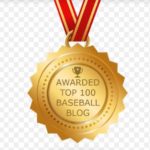 Baseball Roundtable is on the Feedspot list of the Top 100 Baseball Blogs. To see the full list, click here.
Baseball Roundtable is on the Feedspot list of the Top 100 Baseball Blogs. To see the full list, click here.
I tweet baseball @DavidBBRT
Follow/Like Baseball Roundtable’s Facebook Page here. More baseball commentary; blog post notifications; PRIZES.
Member: Society for American Baseball Research (SABR); Negro Leagues Baseball Museum; The Baseball Reliquary.
